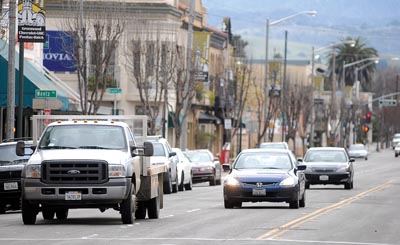An electrical vehicle charging station could be installed in San
Benito County
– most likely in Hollister – by August as part of a regional
program to encourage use of the environmentally-friendly
vehicles.
An electrical vehicle charging station could be installed in San Benito County – most likely in Hollister – by August as part of a regional program to encourage use of the environmentally-friendly vehicles.
The Association of Monterey Bay Area Governments, comprised of Monterey, Santa Cruz and San Benito counties, is using a $25,000 grant from the Monterey Bay Regional Air Pollution Control District to install at least one public charging station in each county by the end of the summer.
Bids are being sought from contractors to install the stations, which are “a little bit bigger than a standard parking meter,” according to Linda Meckel, project manager for AMBAG.
Read the Free Lance on Twitter here.
“They’re designed to not be too intrusive,” she said, noting that the stations – essentially encompassing the same area as a parking space – can handle one or two vehicles at a time, charging them within two to four hours depending on the size of a car’s battery.
“Public charging (of electric vehicles) is a newer thing,” she said. “It’s meant for when you forgot to plug in your car at night or you don’t have access to a charging station at home. Or perhaps if you drove over 100 miles and you need to recharge the battery.”
The exact sites for and numbers of the charging stations will be determined once a contractor is selected to install them. AMBAG will rank the feasibility of various locations using factors such as the level of activity in an area and whether electric vehicle owners are likely to be there for one to three hours at a time. Such places include restaurants, theaters, malls, government facilities, parks and libraries.
There is a “slight economic development incentive” associated with the public charging stations, which will accept credit cards as payment for the electricity – at about $3.50 per 100 miles or 12 cents per kilowatt hour. Most batteries hold a 24 to 36 kilowatt hour charge, Meckel said.
“If you came into Hollister as a tourist and drove 40 miles, you could charge your car for a little bit,” she said. “It could encourage people to be downtown.”
San Benito County’s residents could also benefit from the station, she said, topping off downtown while having dinner or visiting a store.
The number of electric vehicles in use in the region “is really difficult to get from the DMV,” Meckel said, though she said there are a lot of those vehicle owners visiting the region. More electric vehicles are also being turned out by the auto industry.
“We’re trying to make sure we have the infrastructure in place so that when those cars do come to market, people are not hesitant to buy them,” she said, referring to what has been termed “range anxiety,” or the fear that people have about being stranded without a place to recharge their electric car’s battery.
While AMBAG has not yet had discussions with Hollister officials about the electric vehicle charging stations, Meckel said individual cities would be responsible for maintaining the sites.
“We have to enter into agreements with the cities,” she said. “It’s infrastructure, but it could be a break-even or money-making endeavor,” with cities receiving some of the revenue from the charging stations.










